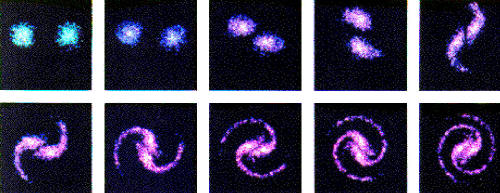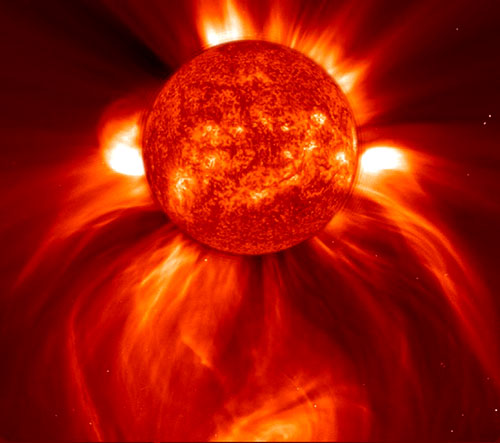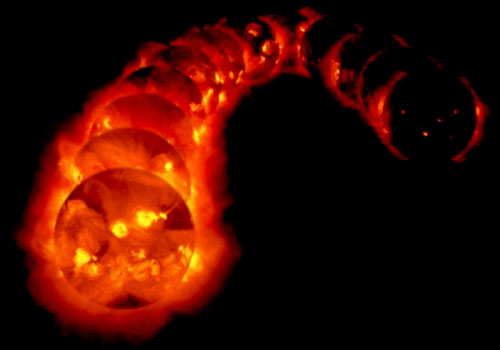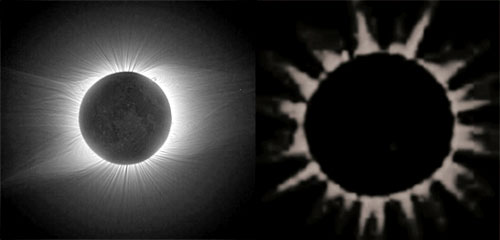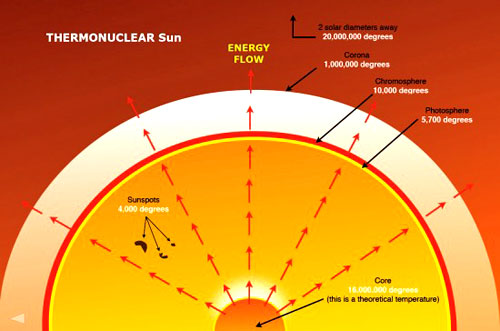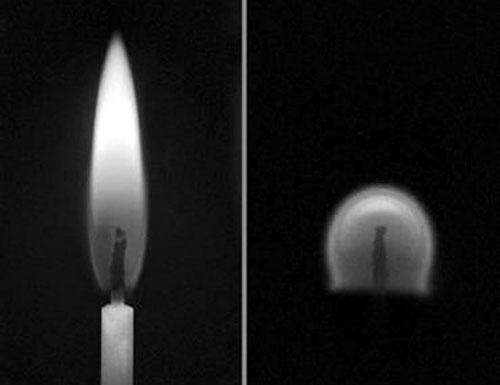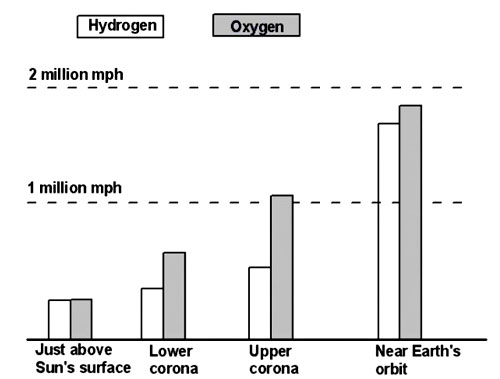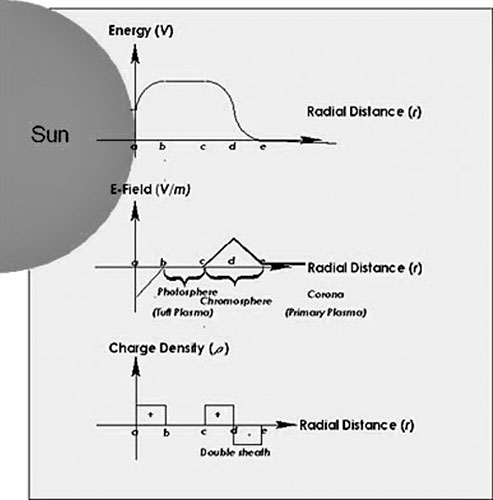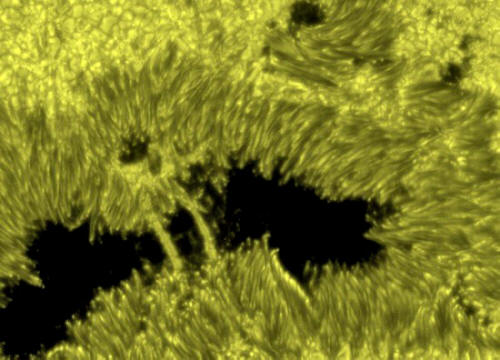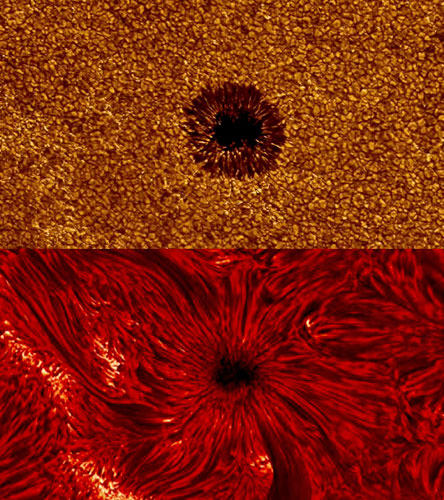|
|
|
by David Talbott December 2011 from Thuntherbolts Website
December 5, 2011
In the twentieth century, pioneers of
plasma cosmology began to identify the crucial role of electric
currents in interstellar and intergalactic space.
Additionally, we will offer
pointers to the recent interdisciplinary contributions of others
toward a new understanding of electricity in space.
1. The Sun and the
Cosmos
Conversely, as we learn
more about the Sun, this knowledge has the potential to challenge
longstanding ideas about the universe as a whole.
Though this core dogma grew more
complicated with the advent of relativity theory, then more
complicated still by a continuous stream of space age surprises,
gravity remained supreme. It is the weakest of the fundamental
forces known to science, but the prior theoretical “consensus”
continued to treat gravity as the only fundamental force capable of
acting across cosmological distances.
We now know that space is not empty, but filled with charged particles, a sea of conductive plasma, albeit extremely rarefied. Rapidly accumulating evidence suggests that electric currents flow across intergalactic, interstellar, and interplanetary space, contributing directly - often decisively - to the evolution of cosmic structure.
As today’s theorists come to acknowledge this role, the picture of
space will be forever changed.
That requirement, in turn, could only dissuade cosmologists from asking the most fundamental question:
Given our proximity to the Sun and the immanent opportunity to take electrical measurements close to the dynamic activity of the Sun, perhaps no subject offers a more complete window to the roles of plasma and associated electric currents in space.
What will the results be for our thinking about the more remote cosmic expanse?
As new telescopes and probes extended the frontiers of human knowledge, space came alive with electromagnetic activity.
Technicians and engineers of the space age
delivered to the theoretical sciences all the evidence needed to
confirm the existence of electric currents and of the magnetic
fields these currents produce across the farthest reaches of space. Fig. 1. Amongst the countless surprises from space in recent decades is this axial jet of galaxy M87, captured by the Hubble Space Telescope in 1994. The coherent jet, spanning thousands of light-years, together with the galaxy’s intense synchrotron radiation, continue to baffle astronomers. But electrical theorist Hannes Alfvén had predicted galactic synchrotron radiation as early as 1950. 2
The new picture removed the assumptions of textbook cosmology formulated prior to the space age.
Now, the
steady stream of surprises remind us of earlier visionaries, from Kristian Birkeland,
Nikola Tesla, and Irving Langmuir to the founder
of plasma cosmology,
Hannes Alfvén, all of whom anticipated the role
of electricity in cosmic events. [3]
The point was stated bluntly by the eminent solar physicist Eugene Parker,
However, Alfvén and his colleagues recognized that intricate cosmic structure and high-energy events in space are the witnesses to electric currents threading the sea of interstellar and intergalactic plasma.
For example, we now detect the “hum” of these
cosmic power lines by their radio signals. [5]
More intense focusing of this current flow will often generate explosive electric discharge, and the consequent electromagnetic radiation can include - at the highest energies - “synchrotron” radiation, now abundantly observed in space. Intense electric fields remain the only plausible explanation.
But when Alfvén predicted galactic synchrotron
radiation, astronomers did not respond. Electric fields in space had
not yet entered their lexicon.
3. How Galaxies Form
in Plasma Cosmology
Galaxies are often dwarfed by the full extent of electromagnetic radiation in their surroundings, and the source of these energies must be taken into account. In the plasma universe, electric currents will intersect at critical points to drive an electric vortex, giving birth to spiral galaxies.
This envisioned behavior of electricity in space is based on the
laboratory observation of electric currents and electric discharge
in plasma, together with supercomputer simulations of the way
charged particles interact under the influence of electric currents. Fig. 2. Supercomputer simulation of spiral galaxy formation by Anthony Peratt,
based on charged
particle interactions.
6 This model was elaborated by one of Alfvén’s long-standing students and collaborators, the leading plasma scientist Anthony Peratt in 1986.
An expert on high-energy
plasma instabilities and author of The Plasma Universe, [7]
Peratt used a super computer to simulate the behavior of a cloud of
charge (a particle-in-cell simulation) illustrating the manner in
which electric currents in plasma will generate the familiar shape
of spiral galaxies and of other galactic structures.
On reaching the galactic center, the electric charge that drives these currents is stored in a compact electromagnetic plasmoid - a rotating torus or donut-shaped structure episodically releasing its stored energy as jets along the galaxy’s spin axis. Alfvén concluded that this is how an “active galactic nucleus” (AGN) is born.
From this vantage point, the electrical behavior of the galactic plasmoid, though often hidden by dust, is the confirmation of immense electric potential.
Moreover, in this radical break from earlier theory, the newborn galaxies could in fact be lit by electric lights - the stars strung along galactic filaments as witnesses to interstellar power lines or current streams.
Fig. 3. The galaxy 3C31, depicted on the right, appears as a mere speck within the energetic radio signals that surround it (left).
Credit NRAO/AUI 2006.
4. Why Does the Sun
Shine
Textbooks described the theory as a crowning achievement.
A few decades later the
theory lost its credibility as astronomers realized it could not
account for the emerging billion-year scenarios of Earth evolution.
A new consensus arose, a conviction that only a fusion reactor at the Sun’s core could explain the Sun’s powerful emissions of heat and light. And now every student in the sciences reads about the hypothesis as fact.
Hans Bethe,
But now a radically new view is possible.
Could the Sun’s light and its entire range of electromagnetic activity be partly or entirely due to the flow of electric currents into and through the heliosphere? The ”electric Sun” hypothesis challenges the assumption of a solar nuclear furnace, and its roots reach as deep into intellectual history as those of the nuclear model.
Yet you will not
see it mentioned in any standard astronomy text.
Fig. 4. Is this eruption of the Sun due exclusively to a power source at the Sun’s core? Or is the Sun responding to a vastly larger electrical environment? Credit: SOHO (ESA & NASA).
5. The Electric Sun - A Brief History
The work of
others fed into the present concept as well.
It was this
observation that opened the path of his life’s work, [11]
leading to the conclusion that the appearance of solar flares, their
temperature, and their spectra, provided a perfect match with
lightning. The visible surface or photosphere of the Sun appears to
be animated by electric discharge. [12]
His answer to these contradictions was to suggest that the Sun is the focus of a galaxy-powered “glow discharge.” [13]
With this, Juergens was effectively the
first to argue that the Sun is actually powered by electricity
rather than nuclear fusion.
Thornhill has since devoted much of his life to researching this new paradigm and the core tenet of an electric Sun. [14] The work of Thornhill and his colleagues led to a broad interdisciplinary synthesis attracting researchers from around the world.
One such researcher was retired professor of electrical engineering, Donald Scott, author of the recently published book, The Electric Sky. [15]
A centerpiece of the book is the
electric Sun hypothesis.
6. Glow Discharge (Geissler
Tube)
The concept would extend the plasma universe to the observed features of individual stars. From this perspective, electric currents flowing along galactic arms are pinched into focal points of star formation (the z-pinch effect).
Stars can then be seen in an
electrical connection to the stored energies of the plasma oceans
through which galaxies and galactic clusters move. Fig. 5. Geissler tube. As pressure is reduced within the glass tube,
changes occur in the
glow discharge. The electrical hypothesis envisions the Sun immersed in a medium of extremely low-density plasma.
Its glow discharge is similar to that of a Geissler tube. Only very close to the Sun will the concentration of atoms be sufficient to excite them to emit visible light. We see that light as the photosphere and the corona, but the “atmosphere” of the Sun extends outward as the plasma medium through which the planets move, all affected by heliospheric currents, the invisible movement of charge.
Together
with the Sun itself, electrical activity within
the heliosphere and
beyond provides a laboratory in space for evaluating the electric
Sun hypothesis.
It must extend also to the galactic neighborhood, where
currents flow along galactic arms. And it must even reach beyond the
Milky Way to the unfathomable power now evident in intergalactic
space.
As noted, astronomers considered the most basic issue - the source of the Sun’s heat and light - to be fully resolved as we launched satellites and probes into space. Certainly, no one believed that a retroactive assessment of the fusion model would be necessary.
And no one seemed to blink when the one and only
quantitative argument for the Sun’s nuclear core failed, as the
neutrino count came in at a third to a half of the theoretically
required figure.
7. The Role of
Empirical Evidence
A
useful model will spell out proposed relationships between causes
and effects. Causes are hypothesized and the claimed effects are
named. A new model can then be generalized to see how well its
underlying assumptions correlate with more detailed observations and
a broader range of measurements bearing on the question.
Carried out properly, this essential phase will throw a spotlight on weaknesses or outright failures of a theory, if they exist. This is where we look for contradictions, things that don’t fit the underlying assumptions.
“Provably wrong if incorrect” is the ideal when stating a theory.
In fact, the most useful models will be
readily falsifiable, and the question of correlation between theory
and observation can be explicitly tested against the full range of
critical data.
A
more narrow field of view will virtually guarantee that at least
some falsifying observations, if they exist, will be ignored.
The original model did not
anticipate, and was never able to explain, the spectacular
acceleration of charged particles away from Sun. No one envisioned
the “impossible” increase in temperature with distance upward from
the solar surface, culminating in 2 million Kelvin at the solar
corona.
And established dogma, exemplified in the work of
mathematician Sydney Chapman, had categorically excluded the
possibility that Earth’s auroras could be caused by electric
currents from the Sun penetrating Earth’s upper atmosphere.
Notes
Quantification
Specialized inquiry can
then test the rigor and precision of the qualitative argument with
equations and numbers. In a successful test, the quantitative
results will correlate well with predictions arising from the
underlying theoretical assumptions; they will add logical strength
and precision to the prior qualitative argument.
The only way to overcome this spectacular deficiency would be to demonstrate a logical pathway of quantified analysis leading from the theoretical starting point to the major attributes of the Sun.
After decades of trying, the promise of a quantified model was never fulfilled, not even in a limited sense. No direct line of reasoning from the assumed nuclear furnace to even one enigmatic attribute of the Sun can be substantiated. And so the specialized debates go on and on, guided by the dogmatic certainty that an acceptable answer must be available.
After 60 years and billions of dollars spent exploring
the Sun, no peer-reviewed article has yet questioned the fusion
model.
Nevertheless, with the
support of popular media, a guess about the “nuclear core” of the
Sun led to a leap of faith. Limitless energy should be available to
humanity by controlling a fusion process - ”just like the controlled
fusion in the center of the sun.”
Globally, governments poured billions upon billions of dollars into research, seeking to replicate the imagined events hidden inside the Sun. From the 1950s onward it was an easy sell. But the only fusion the experiments provoked lasted a second or so - typically much less than a second - and never produced as much energy as was pumped into the experiments.
In physics, that’s the definition of an
unworkable idea - and it’s very likely the most expensive failure of
theory the world has ever witnessed. [16]
Contrasting Theory
and Observation
In
the electrical alternative, the Sun’s energetic output is
largely - perhaps entirely - the consequence of external electric
fields and the heliospheric movement of charged particles, powered
by circuitry along the arms of the Milky Way. Given the volume of
available data, a comparative test of predictive failure and
predictive success is long overdue.
To see that this is so, one
must trace the connection between theoretical assumptions and their
inescapable implications. Wherever the implications are logical
requirements of the model, the absence of the predicted findings
will amount to falsification of the model as stated.
Traditional theory assumes that, over hundreds of thousands of years, heat from a fusion reaction at the Sun’s core travels first through a supposed “radiative zone.”
It then rushes upward through an imagined “convective zone” to create the Sun’s visible surface, the photosphere. Unexplained events then energize the chromosphere and corona from below.
But why would this theorized process produce
highly constant visible light but much more variable extreme UV
light and X-rays above the photoshere?
The only known analogies for nuclear fusion are at the extremes of inconstancy: on the one hand a hydrogen bomb and on the other the failed laboratory attempts to control the fusion process.
A hydrogen bomb underscores the fact
that thermonuclear reaction rates are highly unstable and
particularly sensitive to core temperature. Even a modest increase
in temperatures at the Sun’s core would multiply the likelihood of a
runaway reaction a thousandfold and more.
At the wavelengths of extreme ultraviolet light the Sun’s emissions dimmed by 30% during the last solar minimum, a 300% greater dimming than in visible light. And at the frequency of X-ray generation the Sun is vastly more variable, as seen in the X-ray images of a solar cycle below.
Fig. 6. Solar cycle observed in X-ray emissions.
Credit: the Yohkoh
mission of ISAS(Japan) and NASA. What could be causing a constant Sun at one frequency to become an inconstant Sun at a higher frequency?
From the region below the photosphere, up through the photosphere,
the chromosphere and the transition region, into the corona, we find
an increasing dominance of higher frequencies and greater
variability.
Above the earth - in the ionosphere and Van Allen radiation belt - with energy levels much greater than at the surface. We know that the flow of charged particles and associated energetic activity is not generated from within the Earth. It is a direct result of arriving particles from beyond the Earth, specifically, from the Sun.
Is it not reasonable,
therefore, to ask if the layers of more variable and energetic
activity around the Sun could be due to electrical contributions
from its larger environment, the heliosphere, fed by electrical
currents along the arms of the Milky Way?
It maintains the photosphere’s steady
radiation of heat and light while the power input varies during the
sunspot cycle and other changes in electrical input.
So the tufted plasma of the photosphere (B-C) acts as a
barrier, limiting the Sun’s power output. When it is breached we see
gigantic coronal mass ejections. Fig. 7. The Sun’s implied voltage curve in relation to elevation, as originally envisioned by Ralph Juergens,
and further analyzed
by Wal Thornhill and Donald Scott. Electrical theorists are not surprised by the fact that the most energetic and variable activity of the Sun occurs well above the Sun’s photosphere, in the corona - the spectacular halo which shows up when the Sun’s light is blocked by a solar eclipse (below).
In electrical terms its counterpart is the corona of a glow discharge.
Fig. 8. Left: the corona of the Sun as seen in an eclipse.
Right: glow discharge
in the laboratory
If the Sun were
like a glowing ember or a flame (or a nuclear furnace), one would
expect the temperature to drop off with distance from the central
heat source. Yet, as seen, this is not the case.
Here it abruptly jumps
hundreds of thousands of degrees, then continues slowly rising,
eventually exceeding 2 million degrees. And incredibly, ionized
oxygen at a distance of 1 or 2 solar diameters reaches 200 million
K!
How could this be? he asks. What events are “transporting energy from the cold part to the hot part?”
Pasachoff’s wry assessment is refreshing.
Fig. 9. Schematic illustration of the Sun’s reverse temperature gradient.
Credit: W. Thornhill. But can astronomers and astrophysicists break free from the arbitrary assumption that the energy is “coming from the cold part”?
In fact, the reverse temperature gradient of
the Sun contradicts every original expectation of the thermonuclear
model. However, it mirrors perfectly the behavior of glow discharge
phenomena in the laboratory.
Fig. 10. In contrast to the candle on the left, a candle in a Mir space station experiment produces a luminous surrounding shell, signifying the transaction between
the vaporized wax of
the candle and the external atmospheric oxygen. The inescapable key is the external energy source.
A crude analogy would be the flame of a candle. The relatively cool temperature at the base of the flame gives way to much higher temperature above the candle at the region of maximum exchange with the oxygen-bearing atmosphere. In a weightless environment, as seen in an experiment on the Mir Space Station a few years ago (above), the exchange shows up as a luminous shell around the candle.
The analogy with the corona is crude, but it does illustrate the indispensable external contribution to a reverse temperature gradient.
Nature as we know it offers no contradiction
of this principle.
Electric fields
accelerate charged particles, and it is not reasonable to reject the
obvious when no comparable effect can be achieved by any other known
force in interplanetary space.
In 2010, its speed dropped
by 3%, its temperature by 13%, its density by 20%, and its magnetic
field strength by more than 50%. Why a stable star will send out a
wind of charged particles at widely varying speeds is a mystery with
no apparent connection to anything going on inside the Sun.
In this case the two extremes would be,
Fig. 11. Chart of ion velocities in the solar wind.
From D. Scott, The
Electric Sky. The first problem is that even the more normal ranges of solar wind velocities are beyond the reach of any traditional model. The typical coronal mass ejection (CME) will reach Earth in 15 to 50 hours.
But in January 2005, a CME exploded from the Sun, accelerating so rapidly that it reached Earth in only 30 minutes, producing what NASA scientists called,
The protons reached the Earth at nearly one quarter the speed of
light - a theory-busting test of the nuclear Sun, and a
theory-affirming testament to the electric Sun, the center of a
heliospheric electric field.
Notes
Electric Sun Answers Longstanding Puzzles December 11, 2011
The Sun’s PNP
Transistor
Scott draws our attention to the fact that the three plots provide a stunning match to those of a PNP transistor, while explaining the extreme variability of the solar wind as well:
Energy, electric field strength, and charge density as a function of radial distance from the Sun's surface.
Illustration from Don
Scott’s book The Electric Sky. Could it really be that simple?
The answer is yes, because electric
fields are the most efficient means of accelerating charged
particles, and they are the only known way to accelerate charged
particles up to the higher speeds of the solar wind.
Scientists now believe that each granule
is the top of a “convection cell” because the opaque gases of the
Sun, in the nuclear fusion model, need a mechanism for slowly
transferring internal heat to the surface. The “granulation” must
therefore be the “boiling gases” forced upward by million degree
temperatures beneath the surface.
As one proponent of standard theory concedes,
The statement confirms what Ralph Juergens wrote years earlier:
Juergens proposed instead that,
Fig. 13. On the left, surface granulation of the Sun.
On the right,
sunspots reveal the penumbra filaments beneath the surface “grains.”[22]
and increase in
number as the voltage and current are increased.
Their darkness, structure, and behavior
have required great ingenuity in attempts to explain them. As seen
in the Sunspot image in Fig. 14, the margins of its dark regions
reveal that the granules are the tops of rope-like structures rising
to the photospheric surface. The thermonuclear model identifies
these structures as the “convection currents” that the model
requires.
The explanation requires that magnetic fields do something that magnetic fields are not known to do. (Magnetic fields do not “conceal” extreme temperatures.)
Even if magnetism could perform such a feat, it is surely quite remarkable that solar physicists have yet to find, by peering into a sunspot, even the slightest hint of the supposed extreme temperatures creeping into view.
Fig. 14. The bridges seen reaching across this sunspot highlight the role of charge redistribution in a highly active region just beneath the surface.
Credit: Swedish Solar
Observatory.
In convection, hot gases move upward and
cool. But the penumbral ropes reveal quite the opposite. From their
base, as the plasma rushes upward, they grow hotter. And that’s only
the beginning of the dilemma.
To see the forces actually driving and
configuring the sunspot penumbra one must step back (or “up”) from
the visible surface and follow the paths of the filamentary
structures into the chromosphere above the surface. As seen in the
bottom image in ultraviolet light, the “ropes” of the penumbra do
not stop at the surface of the photosphere, but extend outward
thousands of kilometers across the chromosphere to create a maze of
filaments, all constrained by complex magnetic fields, the
undeniable effect of electric current flow.
The task is to confirm how “something we know to be happening” is actually occurring. So simulations are produced to retrofit observations to imagined processes. And the simulations do indeed show “overturning convection” at the top of the photosphere. Recent developments, however, suggest that solar physicists themselves are beginning to sense that something isn’t right with the model.
In September, 2010 an Astrophysics
Journal article by L.R. Bellot Rubio et al., “Searching for
Overturning Convection in Penumbral Filaments,” cast serious doubt
on the whole idea. [23]
But their conclusion from a diligent observational investigation is that despite “excellent quality” of the data set they worked with,
Fig. 15. Two views of a sunspot at different wavelengths. Upper image is in visible light; lower is in ultraviolet.
Credit: Dutch Open
Telescope/Sterrenkundig Instituut Utrecht.
This is a very strange situation since,
without convection, there is no nuclear fusion model of the Sun.
The logical place to look for an
explanation of photospheric granulation and penumbral behavior will
be in the laboratory, through a detailed study of “anode tufting” in
a low-pressure gas discharge.
It is necessary, he says,
Of course it is important to remember that an electric Sun must be driven by a heliospheric circuit that is itself powered by current flow along the arms of the Milky Way.
Another tuft immediately
replaces each disappearing tuft. That is the power of the heliospheric electric circuit, maintaining the Sun’s glow discharge.
In fact, we find no evidence of events
below powering either the Sun’s surface activity, or the activity
above the surface.
The electrical interpretation of solar flares and CMEs requires a powerful release of charge in the atmosphere above the surface.
And this consideration brings us to a more recent investigation by NASA’s Peter Schuck who sought to determine,
Schuck’s research led him to conclude that the trigger does indeed occur in the atmosphere above the photosphere.
He found that the required velocities of the photospheric plasma to blast the flares upward would be a thousand kilometers per second, speeds that would be easily detected.
What he saw instead,
According to Schuck,
The tragedy is that no level of negative evidence seems powerful enough to throw the core theoretical assumption into doubt.
The NASA story on the study assures us that the energy of the lightning bolt cannot originate in the plasma atmosphere above the surface:
The sunspot cycle, the very existence of the corona, an electrified torus around the solar equator, the relationship of this torus to sunspot behavior and to the “ballerina skirt” of the Sun’s current sheet, super rotation of the Sun’s equatorial photospheric plasma, distribution of coronal holes, bi-polar jets, temperature and energy profiles of chromospheric spicules, and the so-called “open” magnetic field lines connecting the Sun to interstellar space.
These and many other attributes must be
brought into a broader investigation, raising questions that have
not been asked with sufficient seriousness for at least 60 years.
And yet, through the back door, we now see a growing interest in the role of magnetism across the cosmos. In the rarefied plasma environment of space, magnetic fields are the proof of active electric currents, even if this proof is ignored.
But with surprising rapidity, perhaps in the course of just 15 years, the “magnetic universe” has emerged as a permissible expression within the scientific mainstream.
This radical turn may prove to be the
most promising bridge to a shift in astrophysical perception,
eventually making it impossible to ignore the electric currents
without which the “magnetic universe” would disappear.
Perhaps their field of view will extend to electrical
forces acting on comets as they move through the same electric field
of the Sun that accelerates charged particles away from the Sun.
The fact that the dominant space age
surprises consistently point to electrical events, can hardly be
accidental.
Notes
|



